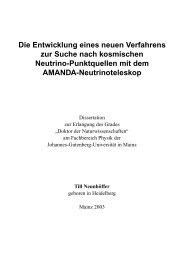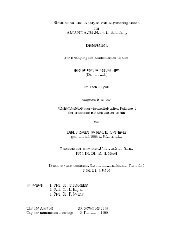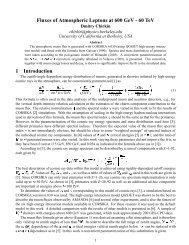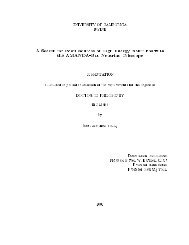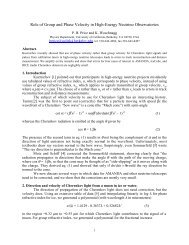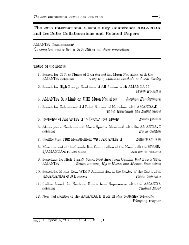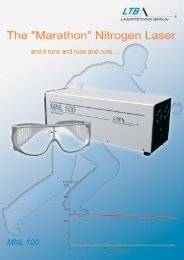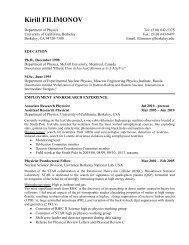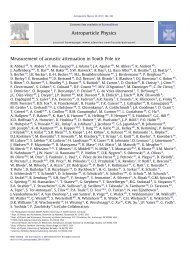Link to Fulltext
Link to Fulltext
Link to Fulltext
You also want an ePaper? Increase the reach of your titles
YUMPU automatically turns print PDFs into web optimized ePapers that Google loves.
- String 4: 26 OMs, all Hamamatsu, all equipped with nylon balls, all facing down except<br />
OM#1, 10, 19, 20, 21, 23 and 25. LED modules above OM#1 and 10. Anticipating a<br />
change of technology in the next stage of AMANDA-B and in order <strong>to</strong> perform tests on<br />
them, twisted-pair cables from Ericsson Cable were incorporated in a separate cable instead<br />
of coax for OM#21-26.<br />
In addition, thermis<strong>to</strong>rs and pressure sensors were placed near the <strong>to</strong>p, middle and bot<strong>to</strong>m module<br />
of each string <strong>to</strong> moni<strong>to</strong>r it during deployment.<br />
The most important piece of calibration instrumentation are the two optical fibers going from<br />
the surface where they are coupled <strong>to</strong> a dye laser, <strong>to</strong> a nylon diffuser attached on the main cable<br />
50 cm below each OM. One of them is single mode, with a FWHM time ¥ resolution of ¥ 7 ns<br />
at 530 nm and is used for time-calibration whereas the other is multi-mode with a FWHM time<br />
resolution of 15 ns at the same wavelength. The multi-mode fiber can transmit wavelengths<br />
¥<br />
of 450 nm and longer and is used for inter-string data collection mainly.<br />
Time-calibration of the PMs is performed by pulsing a laser connected <strong>to</strong> these fibers at the<br />
surface and, knowing the time at which the pulse reached the nylon ball, the time it takes for the<br />
PM signal <strong>to</strong> reach the surface can easily be found. That time is the sum of the PM’s transit time<br />
and of the travel-time through the cable of the electrical pulse it sent out. A dye-laser was used<br />
in 1996 <strong>to</strong> take such calibration data at a 10 Hz rate.<br />
These measurements were performed on each OM individually, at their ¢¡ § -gain voltage, so<br />
the requirement on the light output for that purpose was not very high. However, the maximum<br />
intensity that can be sent out at the diffusers is ¢¡ ¦ pho<strong>to</strong>ns/pulse, which makes it possible <strong>to</strong> reach<br />
neighboring strings. This was used <strong>to</strong> acquire data used in ice analysis and position calibration.<br />
The laser which was installed at a depth of 1830 m on string 1 contains a -laser, built at<br />
¢¡<br />
UCB [35]. It has a maximum intensity of pho<strong>to</strong>ns/pulse, which makes it easily detectable<br />
by OMs more than 200 m away. The laser emits light isotropically at a single wavelength of<br />
337 nm in a §<br />
sr up-looking solid angle. It is pulsed at a 6 Hz rate, with a time resolution of<br />
ns. ¥ The ¥<br />
¥¦ ¢¡<br />
Three halogen DC-lamps were also deployed, one broadband with a maximum intensity of<br />
pho<strong>to</strong>ns/second and two with a maximum intensity of ¡ pho<strong>to</strong>ns/second equipped with filters<br />
at 350 nm and 380 nm respectively. The main purpose of these light sources was <strong>to</strong> measure the<br />
relative pho<strong>to</strong>n flux as a function of distance from the source.<br />
The several LED beacons installed on strings 1, 2 and 4 can either be pulsed at 500 Hz with<br />
a maximum intensity of ¡ £ pho<strong>to</strong>ns/pulse or used in DC mode with ¢¡ £ pho<strong>to</strong>ns/sec. They emit<br />
light with a wavelength 380 nm and 450 nm.<br />
A second harmonic genera<strong>to</strong>r (SHG) was also installed, which can send pulses of light at 532<br />
nm wavelength (doubling the frequency of 1064 nm light sent down the fiber from the surface)<br />
with a time resolution of 7 ns and an intensity of ¢¡ pho<strong>to</strong>ns/pulse.<br />
Six more strings were added during the 96/97 season, which make up the AMANDA-B10<br />
detec<strong>to</strong>r, <strong>to</strong>gether with AMANDA-B4. The cables composing these added strings were of a different<br />
construction than the first four, using twisted-pair instead of coaxial cables for signal transmission<br />
allowing for 36 OMs instead of a maximum of 20 OMs per string.<br />
<br />
¢¡ © fluorescence contamination is taken care of by a filter at the diffuser.<br />
22



